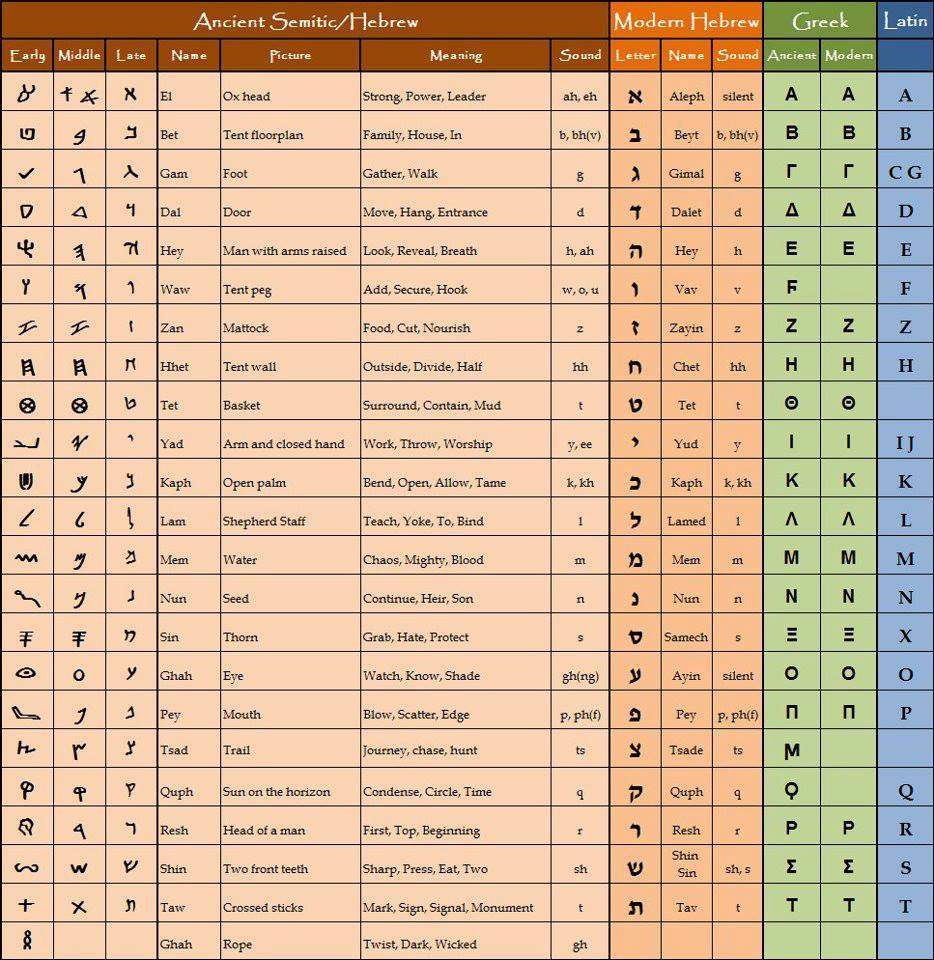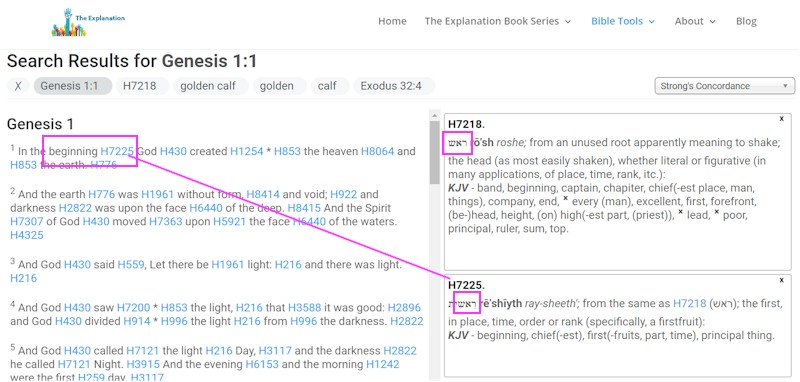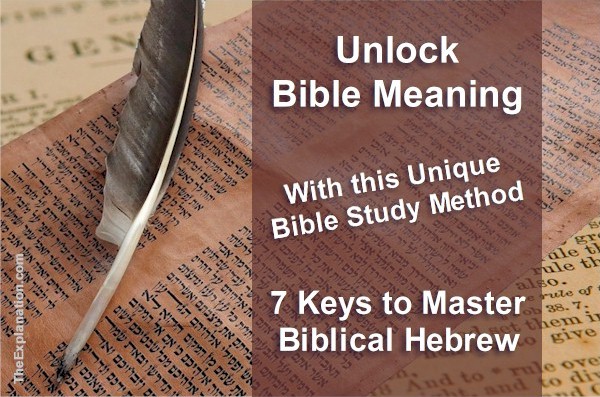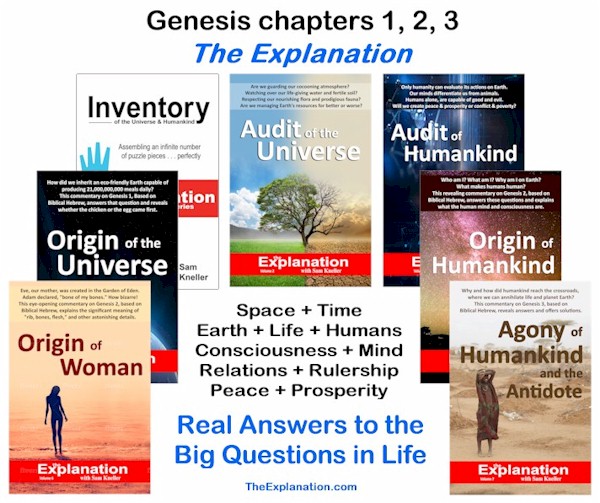Contents
Understanding Concrete and Abstract meanings for Biblical Hebrew words opens your mind to more profound and mature spiritual comprehension.

Concrete and abstract meanings for Biblical Hebrew words is key 3 to unlock Bible meaning.
How would you express the word hand’ on a piece of paper or stone? How would you help someone blind to know what a hand is? You’d draw its outline, and you would take a person’s hand and put it on your hand, This is very concrete. But now, how would you represent the concept of success, or the idea: you accomplished a task with success?. Well, you could use a sign or symbol of something concrete to denote the notion. Traditionally, we use the thumb-up gesture 👍 to convey success. Concrete and abstract meaning happens when we use the former to reveal the latter.
(Bible Course, Unlock Bible Meaning with the 7 Keys to Master Biblical Hebrew, Key 3)
Children never know the difference between concrete and abstract. You can talk about love, read them poetry about love, show them films about love, they won’t understand. Take them in your arms and cuddle them. Fondle them, play with them, help them, be there for them. It takes a lot of concrete acts for kids to incorporate the notion of love.
With concrete and abstract, the former precedes the latter. The former leads to the latter. By drawing a heart, ❤ we express the sentiment of love. Today we use a light bulb 💡 to depict a bright idea or that aha, eye-opening moment.
Pictograms and smileys are the Summum of concrete and abstract. Also called emoticons or emotion icons. Today we use thousands of pictograms, icons, and smileys to express our emotions and feelings. Short forms to relay our deep sentiments. With a simple image, we can convey our feelings around the world instantly. With two keystrokes, we can produce a smiley :). I need not say anything. The concrete symbol transmits the abstract feeling directly to your mind.
We think this is a modern form of expression. In fact, it goes back to the origins of written language itself when the formation of the alphabets began. Biblical Hebrew goes back to those origins when letters and words represented concrete, tangible, visible items like a: hand, house, or a head.
Your language and Biblical Hebrew are replete with concrete and abstract notions. The concrete expressing the abstract. It is so natural to each of us in our native language that for another language, or old English for instance, we don’t apply the principle. We witness such expression mainly, even only concretely. Such a shortcoming is a drawback to profound understanding.
The third key to unlock Bible meaning is to master the fact that Biblical Hebrew is overpoweringly concrete and abstract.
Many look at the creation story either as a myth or concretely as a series of events that took place exactly as the Bible relates them. They take the words at FACE value. That’s concrete, and the abstract is missing. We shall see that one loses at least fifty percent of comprehension. And that fifty percent is spiritual comprehension, which means an entire aspect of understanding, the most important, is thrown to the wind. See that last phrase, it illustrates concrete and abstract.
Original Hebrew Alphabet
The original Hebrew alphabet comprised signs representing real objects. Below you can see the first letter aleph, pictured by an ox head and given the meaning strong, power, leader. Do you see the relationship between concrete and abstract? Isn’t this an excellent way to portray strength and potency?
Other tangibles portraying intangibles would be hand describing work, or a tree showing growth/stability. Likewise, a recognizable picture defines an action. A bow portrays reverence, and a handshake depicts agreement.
I would be amiss to not add a word of caution here. Some take this concept too far. They apply these abstract meanings to each letter and by stringing these meanings together they construct stories for each word. Be very, very careful with such a concept. As you can see from the chart below, each letter can easily have three or four different meanings. When you interlace these variants for a five or six-letter word, the number of possibilities can reach into the hundreds. Choosing which meaning for which letter amounts to interpretation, that’s where caution is a must. You cannot arbitrarily attribute a meaning to a letter.
Even deciding what the meaning of each letter is, poses other questions. For instance, the aleph, the first letter of the alphabet designates El which means God (or god). It has the pictogram of an ox head, which, as you know, was the symbol of the Egyptian god, the Apis Bull, which refers to the Golden Calf that the Israelites worshipped in Exodus 32. Maybe you wondered why they poured their gold into a calf. Egyptian worship still impregnated them with disastrous results. It was idolatry. The lesson is God is not an Apis Bullhead.
The chart below is ONLY given to show that tangible signs represent INtangible concepts. Bible context must confirm those abstract ideas.

The Hebrew alphabet demonstrates concrete and abstract usage of Biblical Hebrew.
Notice the letters and their meanings, both concrete and abstract. Read the 22 letters, and in the column, Meaning, realize that often there are both concrete things, and abstract concepts. For example, the Mem (13th letter) has the picture water (mayim in Hebrew), and the concrete meaning blood, and the abstract meanings of chaos and mighty.
You can read about the history of the Latin script which derives from Egyptian hieroglyphics via Greek. A Semitic alphabet which is similarly concrete and abstract. But they do not teach us these notions in school. Teachers show us how to write, but not why or where the alphabets and writing come from. The Explanation discussed the origin of language in the context of the singularity of humankind.
Hebrew is a very concrete language because it uses the practical to express the abstract:
Beginning – ray-sheeth
Did you know that the first word of the Bible, in the book of Genesis, is actually this word head. There, translated by probably the best known Bible quotation: “in the beginning”.
The English word beginning comes from רֵאשִׁית – ray-sheeth. That’s Strong’s H7225. This is the moment you get to practice.
- Go to UnlockBibleMeaning.com, you’ll be in Genesis 1.
- On the right side, choose ‘Strong’s Concordance’ in the short drop-down menu.
- Click on H7225 beside beginning.
- The annotation will open in the right window.

Bginning-ray-sheet, Strong’s H7225. Example of concrete and abstract meanings for Biblical Hebrew words.
Read the words following the KJV (King James Version). Those are how the KJV scholars translated this Hebrew word from the Masoretic text. Notice ‘from the same as H7218.’ Click on H7218 and you’ll see that reference display just above the present one.
What allows Strong to state ‘from the SAME as?’ Notice the letters in the spelling. You don’t have to read this, just compare the three letters רֵאשִׁ (from right to left: raish, aleph, shin) pronounced rosh. The three letters are identical for H7225 and H7218, that’s why they are the SAME. Again, see how the KJV renders this word: band, beginning, captain, chapiter, chief(-est place, man, things), company, end, excellent, first, forefront, (be-)head, height, (on) high(-est part, (priest)), principal, ruler, sum, top.
Note that this confirms both Key 1, multiple English words for ONE Biblical Hebrew word. Same with Key 2. Did you notice (be-)head That’s very much in contrast to head, Key 2 to unlock Bible meaning with the study method to master Biblical Hebrew.
Notice also that you’re understanding the meaning of the ORIGINAL Hebrew without having to learn any grammar or vocabulary. Not even the alphabet. No fuss That’s what this course is all about.
In English, obviously, we know what a head is. And we don’t always make the association with other uses of this word. Look at these: headmaster, headspace, header, heading, headlines, headland, headnote, headquarters, headwind. When we think about our own language, we can see this key in action as well.
Excellent
Understanding some of the 17 KJV translated words of H7218 helps us see that this beginning was excellent, another rendering of this same Hebrew word. I’m sure you see the relationship. But that’s an ABSTRACT one. Here’s the verse where רֹאשׁ (H7218), associated with רֵאשִׁית (H7225) is rendered excellent.
Let the righteous smite me; it shall be a kindness: and let him reprove me; it shall be an excellent (H7218) oil, which shall not break my head: for yet my prayer also shall be in their calamities.
Excellent oil is from the first cold pressing. It gives the highest quality and purity. See the relationship between head and beginning? Head and excellent? Concrete and abstract. Beginnings, especially when God is involved are excellent.
But this is important, considering the next verse in Gen. 1:2 tells us there was chaos. If the Bible associates beginning with excellent how do we explain the chaos? This is what I mean by having some ABSTRACT as well as CONCRETE meaning from a translation, but not having full comprehension. As a result, Genesis 1:1 has more interpretations than ever. And if you get the first sentence in a story wrong, how can you really understand the rest?
If you’re curious, you can read about this apparent contradiction here. I assure you there’s no opposition in understanding. It’s a matter of grasping what happened in Genesis 1:1-2 and WHY the author expressed it this way to open the Bible narrative.
For now, retain this third key that the concrete, tangible, physical words that your hands can reach out and touch like head represent abstract conceptual ideas that emanate from the mind like excellent.
Examples for which Biblical Hebrew must designate a concrete departure point include emotions, feelings, ideas, and concepts. For instance, the concrete flaring of the nostrils represents the emotion of anger.
Exercise
We’re using the phrase, “And the evening and the morning were the…” Similarly day and night. This repeats itself throughout Genesis 1. Evening, night, morning, and day are CONCRETE elements we SEE every day. They also have an ABSTRACT meaning. Could it be, the abstract instruction is of major importance to our comprehension. The answer is yes, it is.
Go to UnlockBibleMeaning.com. Search for these words in Genesis 1 and make a little comparative chart. Column one, our English word, column two, the concrete meaning, which we read in Genesis 1. Column three, the ABSTRACT meaning which the KJV translators (not Strong, not Sam Kneller) give us.
This is an ongoing exercise to which we shall return. You can figure this out. And I want you to do it, to begin to master this study method.
Know – Yada
Know is one of the commonest words in English. We use it to refer to knowledge and associated concepts like understanding and comprehension. We find the same usage in the Bible. “For God does know (H3045) that in the day you eat thereof, then your eyes shall be opened, and you shall be as gods, knowing (H3045) good and evil” (Genesis 3:5).
A second meaning of know is when you’re acquainted with another person. You meet and get to know that individual. Knowing someone is an abstract concept difficult to picture. The more time you spend in the company of another person the better you get to know them and the initial contact can turn into a friendship and even an intimate relationship. Then, you know a person deeply to where you can read each other’s minds. Profound, but how do you express knowing someone?
The Bible uses the term know—yada (H3045) CIONCRETEly that has deep ABSTRACT relationship meaning and consequences.
“And Adam knew (H3045) Eve his wife; and she conceived, and bare Cain” (Genesis 4:1).
Adam had sexual intercourse with his wife, who gave birth to Cain. Know is concrete via sexual relations and abstract via being acquainted with another person. Ask yourself the question, what is the connection between these two somewhat unrelated concepts?
יָדַע yâdaʻ yaw-dah’; a primitive root; to know (properly, to ascertain by seeing); used in a great variety of senses, figuratively, literally, euphemistically and inferentially (including observation, care, recognition; and causatively, instruction, designation, punishment, etc.):
KJV – acknowledge, acquaintance(-ted with), advise, answer, appoint, assuredly, be aware, (un-) awares, can(-not), certainly, comprehend, consider, ⨯ could they, cunning, declare, be diligent, (can, cause to) discern, discover, endued with, familiar friend, famous, feel, can have, be (ig-) norant, instruct, kinsfolk, kinsman, (cause to let, make) know, (come to give, have, take) knowledge, have (knowledge), (be, make, make to be, make self) known, + be learned, + lie by man, mark, perceive, privy to, ⨯ prognosticator, regard, have respect, skilful, shew, can (man of) skill, be sure, of a surety, teach, (can) tell, understand, have (understanding), ⨯ will be, wist, wit, wot.
They are very connected and we would be well advised to both be aware and reactive to this principle. It is about sexual relationships and deeply knowing each other in marriage.
Today, because of liberal morals, we attribute little importance to the sexual relationships between two people. A consenting exchange of eyes, a message on social media, and two unknowns are jumping into coitus. Our society has brought sex to the forefront, so much so that a lot of couples base their consent on sexual compatibility. That’s not the basis of a lasting relationship. Beauty, muscles, breasts, body tone, face and hair run down with time and shrivel up. That CONCRETE sexual relationship, that physical knowing of the partner fades with age.
What shouldn’t fade is the abstract, friendly acquaintance of your partner. After years, you know your partner inside out. You’re at total ease and comfortable sharing your interests. Your sharing looks, words, touching, soothing, comforting exchanges are the proper rewards of love.
To know your future partner as an intimate friend is the real beginning of a relationship that can lead to a long-lasting, satisfying sexual relationship. Not the other way around.
Long ago, in the very first chapters of the Bible, the Biblical Hebrew teaches us basic life lessons through the concrete and abstract use of vocabulary. In the 21st century with divorce and separation rates what they are, with families disintegrating like never before, the abstract wisdom from the concrete examples and use of vocabulary stand as beacons of the value of God’s Word.
Value of Strong’s Concordance
Dr. James Strong refers to Key 3 to master Biblical Hebrew, concrete and abstract. You can verify these references to see that he refers to concrete and abstract: H6, H488, H539, H5958, H983, H2015, H5315, H7489, H4929, H2017, H4827, H6944.
My intention here is not to explain those references but to show you why we are using Strong’s. As we see from the above references, Strong did refer to concrete and abstract, but rarely includes these terms in his annotations. I believe he understood the concept, but he was more focused on the vocabulary and its organization. And I think we can be very thankful for his highly useful tool.
Remember, this course is not about vocabulary and understanding words. This course is about unlocking Bible meaning. And Key 3, the same Hebrew word having concrete and abstract meanings, is one of the most important, and least understood of all the seven keys.
Beyond vocabulary
The Explanation, via Key 3, has shown the existence of both the concrete and abstract. The latter being emotions, feelings, sentiments, attitudes, qualities. I don’t believe any human being would deny the existence of the abstract.
The existence of the abstract. Now, that’s a strange way of putting it. Why? Because science denies anything you can’t physically SENSE with your five senses. There’s a huge contradiction here. You deny the existence of the intangible, but you accept the existence of the abstract!
Key 3 to master Biblical Hebrew reveals the EXISTENCE of the INtangible. What am I talking about? Genesis 1:2, “And the Spirit of God moved on the face of the waters. You immediately have two INtangibles, God and His Spirit. The verse doesn’t define WHO and WHAT They are, it just states there are non-physical elements. Just like excellence and knowing.
Genesis 1:1-2 is already BEYOND Science. There’s no point trying to debate NON-material elements with pure science. They are incompatible.
Please don’t get me wrong. Science is a fascinating subject. Heavens and Earth and everything created in Genesis 1 are material and wondrous. Science can and does enlighten us on measurable, tangible elements like the age of the Universe and Earth. The shape, diameter and circumference of our planet, including its composition. It tells us about the wonders of animal and plant life. Documentaries display the marvels of nature. All the disciplines of science are useful, but of course, just like with all knowledge, we have to be careful to review it properly. Key 3 is NOT a rejection of Science, to the contrary.
But Key 3 tells us concrete science exists alongside abstract God and His Spirit. They are worlds apart. Key 3 tells us that human consciousness and mind can be, and indeed are, a part of the ABSTRACT. I cannot get into it here, but that’s the understanding of ‘breath of life in Genesis 2:7. That breath of life is both concrete and abstract. Understand this by reading God Breathed into the Nostrils of His Dust Man.
Key 3, concrete and abstract meaning for Biblical Hebrew words and concepts is one of the most revealing and exciting lessons of the Bible.
This blog post is an excerpt from Key 3 of the Bible Course Unlock Bible Meaning with the 7 Keys to Master Biblical Hebrew.
Dig Deeper into The Explanation
Online Study Courses to Uncover the Mystery of Adam and Eve’s Nakedness… with no fuss. Free video mini-course revealing the God-intended meaning of Scripture via Biblical Hebrew. It’s so easy, it’ll blow you away. Join now and add new motivation to your Bible study.
Join The Explanation Newsletter to stay informed of updates. and future events. No obligations, total privacy, unsubscribe anytime, if you want.
The Explanation series of seven books. Free to read online or purchase these valuable commentaries on Genesis 1-3 from your favorite book outlet. E-book and paperback formats are available. Use this link to see the details of each book and buy from your favorite store.

Since you read all the way to here… you liked it. Please use the Social Network links just below to share this information from The Explanation, Key 3. Concrete and Abstract Meanings for Biblical Hebrew Words



Trackbacks/Pingbacks